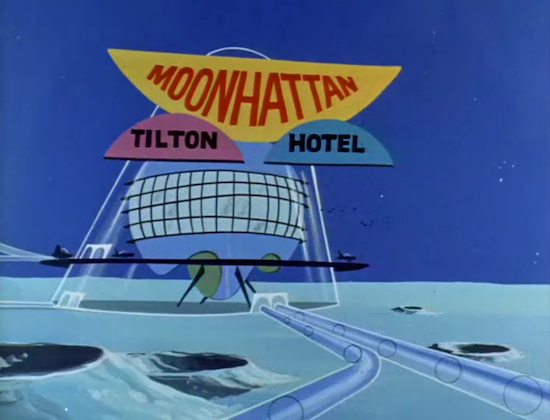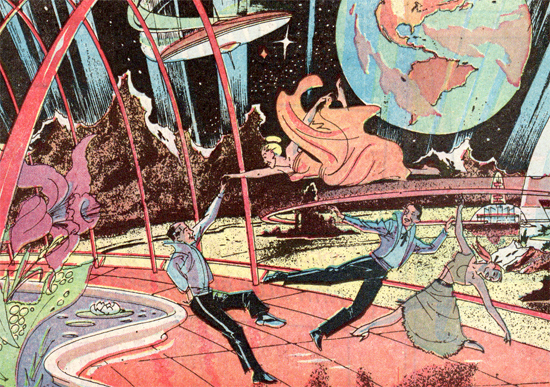Recapping ‘The Jetsons’: Episode 06 – The Good Little Scouts
A camping trip to the moon might seem fanciful, but 1960s advertisers were already promoting space tourism
![]()
![]()
 This is the sixth in a 24-part series looking at every episode of “The Jetsons” TV show from the original 1962-63 season.
This is the sixth in a 24-part series looking at every episode of “The Jetsons” TV show from the original 1962-63 season.
As a child, did you ever think that one day you might be able to vacation on the moon? You weren’t alone. A permanent settlement on the moon wasn’t some crackpot scheme only touted by fringe elements in the mad science community. Scientists, politicians, clergymen and journalists were all promising that once humans inevitably set foot on the moon, permanent settlements (and vacation resorts!) were sure to follow.
The sixth episode of “The Jetsons” revolved around this assumption that the moon would soon be the perfect destination for a Boy Scout-like camping trip. Titled “Good Little Scouts,” the episode originally aired on October 29, 1962 and was probably a pleasant distraction for U.S. viewers from the previous week’s headlines which were all about the Cuban missile crisis. We follow Elroy’s Space Cub troop and their new scout leader, George Jetson, to the moon. The only problem for George? His boss’s son Arthur is along for the ride and—when he goes off wandering the moon by himself—he causes George to get lost and look like a fool.
It’s not stated explicitly, but the sixth episode might provide the first look at a building on the earth’s surface — Grand Central Space-tion. Grand Central clearly takes its architectural cues from the Googie style — more specifically New York’s JFK airport TWA terminal, which was opened in 1962 (the same year as the Jetsons premiere) and designed by Eero Saarinen.

Grand Central Space-tion, from the sixth episode of The Jetsons TV show
In this episode we learn that the moon is a bit like Yellowstone National Park — it has a hotel and some accommodations, but it’s largely unexplored and makes for a great camping trip. The moon has a Moonhattan Tilton Hotel, a play on the name Manhattan Hilton Hotel.

Screenshot of the Moonhattan Tilton Hotel, a parody of the Manhattan Hilton Hotel
Fans of the AMC TV show “Mad Men” may recall a storyline wherein Conrad Hilton, the head of the Hilton hotel chain, wants an advertising campaign that includes a Hilton on the moon. This story arc wasn’t entirely fictional. The Hilton company (most especially Barron Hilton, one of Conrad’s sons) was known for their various promotions in the late 1950s and throughout the 1960s that promised they would be the first hotel on the moon. They even had futuristic moon hotel keys made, which you can see over at BBC Future, where I’ve written about various visions the people at Hilton had for hotels on the moon.

June 1, 1958 edition of the Sunday comic strip Closer Than We Think featuring honeymooners on the moon
Just as “The Jetsons” was inspired by futuristic ideas of the day and turned them even more fantastical, so too did Arthur Radebaugh‘s “Closer Than We Think” sift through the news stories of the late 1950s and early 1960s looking for predictions that could be heightened through fanciful illustration. As we looked at in February, the techno-utopians of the late 1950s were convinced that the Space Age would bring about a wondrous future of moon tourism. The June 1, 1958 edition of “Closer Than We Think” showed two couples dancing the night away in low gravity as they honeymoon on the moon; the earth sparkling in the distance.
Scenic spots on the moon, in years ahead, may become honeymoon havens, like Niagara Falls today. Newly wedded couples will be able to fly to a low-cost lunar holiday in a space craft propelled by thermo-nuclear energy. Space expert Wernher von Braun foresees pressurized, air-conditioned excursion hotels and small cottages on the moon. Couples could dance gaily there, whirling high in the air due to reduced gravity pull, and look out on a strange, spectacular scenery — part of which would be a spaceman’s view of the familiar outlines of the continents of the earth.
And it wasn’t just comic strip illustrators who saw humans living on the moon as a certainty. Insurance companies, banks and other financial institutions aren’t usually known for their exaggerated science fiction claims in advertising, but the early 1960s saw just that with a newspaper advertisement from 1962 for Michigan Mutual Liability. The ad imagined that by the year 2012 we’d be picnicking on Mars and have suburban-style homes on the moon.

George with Elroy’s Space Cubs troop where they’ve become lost on the moon
This Jetsons episode is a perfect example of the Jetson formula that uses absurdist cartoon logic (complete with green, two-head Martians on the moon) but still manages to plant the seed of a wondrous future for 21st century humans in space. Recognizing how many kids were watching this episode on repeat throughout the 1960s, ’70s and ’80s, it’s easy to see why so many people continue to ask, where’s my vacation on the moon?
/https://tf-cmsv2-smithsonianmag-media.s3.amazonaws.com/accounts/headshot/matt-novak-240.jpg)
/https://tf-cmsv2-smithsonianmag-media.s3.amazonaws.com/accounts/headshot/matt-novak-240.jpg)